In addition to Lyme disease, ticks can transmit numerous other diseases. The first symptom of these diseases is usually changes to the skin. So, it’s normal to be freaked out if a blister develops at the site of your tick bite. Here’s what you need to know about whether blisters are a sign of tick-borne diseases like Lyme and whether you should be worried.
Bumps Are Common On Tick Bite Sites
Just like with mosquitoes and other animals which feed on blood, tick saliva contains many different toxins. These toxins have many roles, like keeping the tick bite painless so the host doesn’t notice it and preventing blood from coagulating.
It is completely normal to have a skin reaction to these toxins in the tick saliva. A red bump will often form at the tick bite site. The bump (the medical term is a papule) usually firm and is often itchy. While it isn’t as common as a papule, a fluid-filled blister can also form. Bumps and blisters at the site of a tick bite will usually form while the tick is still attached or soon after it has been removed. You’ll likely have a bump if the tick head got stuck in your skin.
Also read: Why Does My Tick Bite Itch So Much?
The pictures below show a blister-like bump at the site of the tick bite while it is still attached and immediately after removal. These bumps are normal and nothing to be worried about.
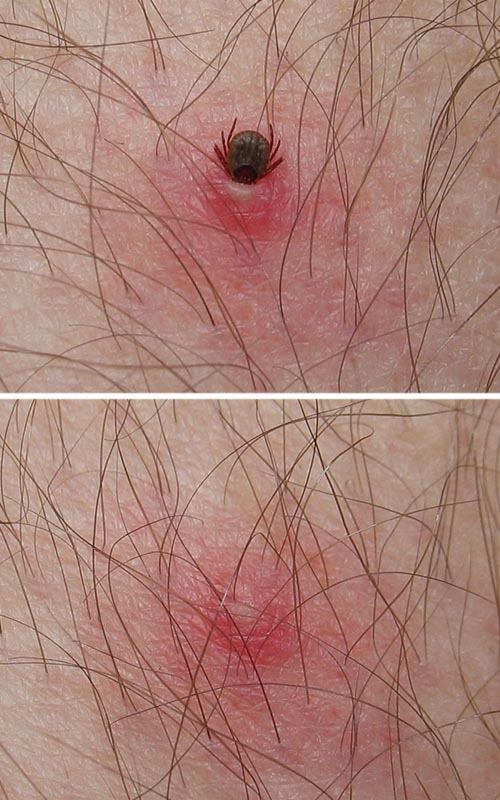
When a Blister Is a Sign of Lyme Disease
While bumps and blisters at the tick bite site usually aren’t anything to worry about, there are some situations where you should be concerned.
Be concerned if:
- The blister appears several days or weeks after getting bit, especially if you are black or a person of color. It is harder to see the signature Lyme disease rash on dark skin, so the blister might be the only visible sign of Lyme.
- It is surrounded by a reddish rash, especially a rash that expands in size.
- Other symptoms of Lyme disease appear, such as fever, fatigue or joint pain.
Note: Remember that Lyme disease is unlikely if you remove the tick within 24 hours. It’s important that you don’t squeeze or irritate the tick while removing it though or the tick might regurgitate its stomach contents into your skin. You’ll need a tick removal tool to prevent this.
Don’t head into the wilderness unprepared! Get my PRINTABLE
Camping Cheat Sheets: An Illustrated Manual
Click to get your hands on this must-have guide!
Pictures of Tick Bite Blisters and Bumps
1. Lyme Disease Rash with Bump at Bite Site
The picture below shows the signature bull’s-eye Lyme disease rash with a raised bump in the center at the site of the tick bite. See more pictures of Lyme disease rash here.
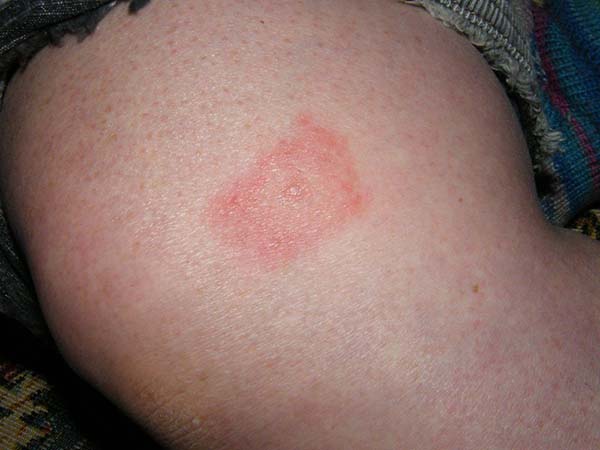
2. Lyme Disease with Blister at Tick Bite Site
Below is a picture of a Lyme disease rash with a blister in the center. It started as a small red bump and, within 4 days, quickly grew into a larger blister lesion surrounded by a red rash. The patient also reported a mild fever, headache, nausea and joint stiffness. You can also see several pictures of Lyme disease with blisters here. You’ll note that all of these blisters were also surrounded by a rash.
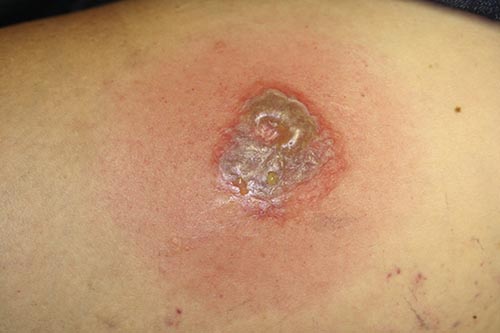
3. Blister and Rash from Cayenne Tick Bite
There are some situations where a tick bite can get a blister and a rash but not be Lyme disease. The picture below shows the site of a Cayenne tick bite (A) immediately after removing the tick, (B) two days later, (C) two weeks later, and (D) two months later.
In this case, the blister and rash weren’t actually a sign of disease. But, you should still get checked if you get a blister and rash like this – especially since it formed so long after getting bit and grew in size!
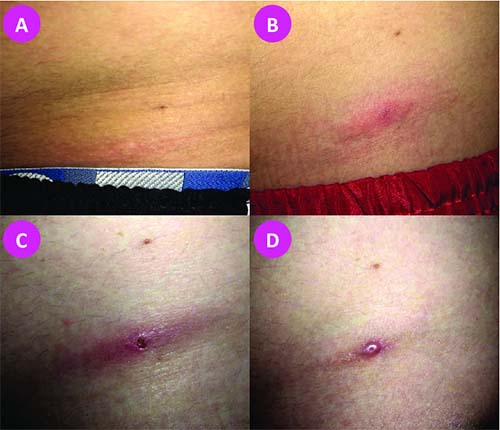
Other Tick Diseases which Cause Blisters
Lyme isn’t the only disease which ticks can transmit. While it isn’t likely, a blister at the site of a tick bite could be a sign of one of these tick diseases.
Bartonella:
Better known as “cat scratch fever,” there’s evidence that ticks can transmit this disease to humans. It is frequently a co-infection with Lyme disease. Bartonella rash usually looks like streaks or stretch marks. However, it sometimes manifests as a blister.
The picture below shows an atypical manifestation of bartonella in which blisters formed.
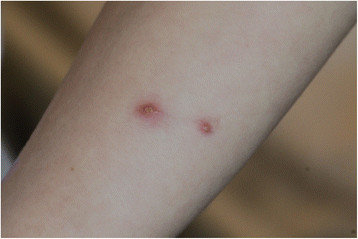
Tularemia:
One of the first signs of tularemia is an ulcer or lesion (though not a blister) at the site of the tick bite. Other signs are swollen and painful lymph glands, inflamed eyes, sore throat, mouth sores, diarrhea or pneumonia.
The image below shows a tularemia lesion.
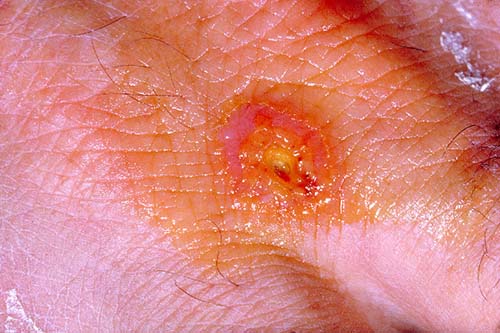
Rickettsia parkeri:
Rickettsia parkeri is a type of spotted fever. One of the first signs of rickettsia parkeri is a skin ulcer or lesion at the tick bite site. It is usually painful and has a dark scab. However, it can look like a blister during the early stages. Other symptoms include fever, headache, muscle aches and a bumpy rash on the trunk, arm and legs.
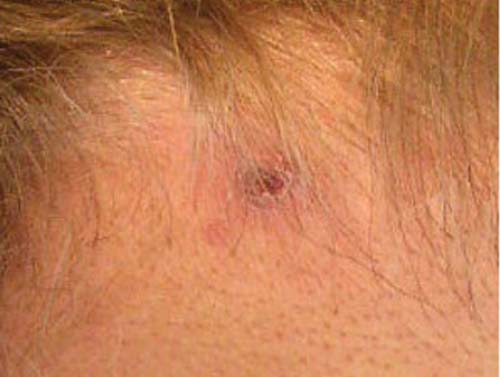
Sources:
https://ijdvl.com/lyme-disease-in-haryana-india/,
https://innovareacademics.in/journals/index.php/ijpps/article/view/41444/25192,
https://www.sciencedirect.com/science/article/abs/pii/S0190962204002671,
https://doctorlib.info/medical/clinical-practice-emergency-medicine/375.html,
https://www.mdpi.com/2227-9032/8/2/157,
https://www.lymedisease.org/lyme-basics/co-infections/bartonella/
https://emergency.cdc.gov/agent/tularemia/faq.asp
https://doctorlib.info/medical/clinical-practice-emergency-medicine/375.html
https://parasitesandvectors.biomedcentral.com/articles/10.1186/s13071-019-3730-2/figures/2 https://www.cdc.gov/ticks/tickbornediseases/rickettsiosis.html
https://www.cdc.gov/otherspottedfever/index.html
Image credits:
Tick Lodged in Human Host by Denys Williams, er the Creative CommonsAttribution-Share Alike 3.0 Unported license
Site of Tick Removal by Denys Williams, er the Creative CommonsAttribution-Share Alike 3.0 Unported license
“Lyme disease” (CC BY-SA 2.0) by monkeypuzzle
Bullous Lyme disease by Jeffrey B. Tiger, MD , Marshall A. Guill III, MD and Shane Chapman, MD. Found at https://www.jaad.org/article/S0190-9622(14)01391-7/fulltext, 2014 American Academy of Dermatology, Inc. Published by Elsevier Inc. CC BY-NC-ND 4.0 license
fig2: Site of the bite of the Cayenne tick Amblyomma cajennense described in the present by Vanessa L. de Souza, Marcos S. de Lima, Thiago F. Martins and José R. L. de Souza. Found at researchgate.net. Creative Commons Attribution 4.0 International license.
Cat scratch disease – active skin lesions (one week after inoculation), by Katarzyna Mazur-Melewska, Katarzyna Jończyk-Potoczna, Anna Mania, et al. Found at https://www.researchgate.net/publication/281576171_The_significance_of_Bartonella_henselae_bacterias_for_oncological_diagnosis_in_children, Creative Commons Attribution 4.0 International


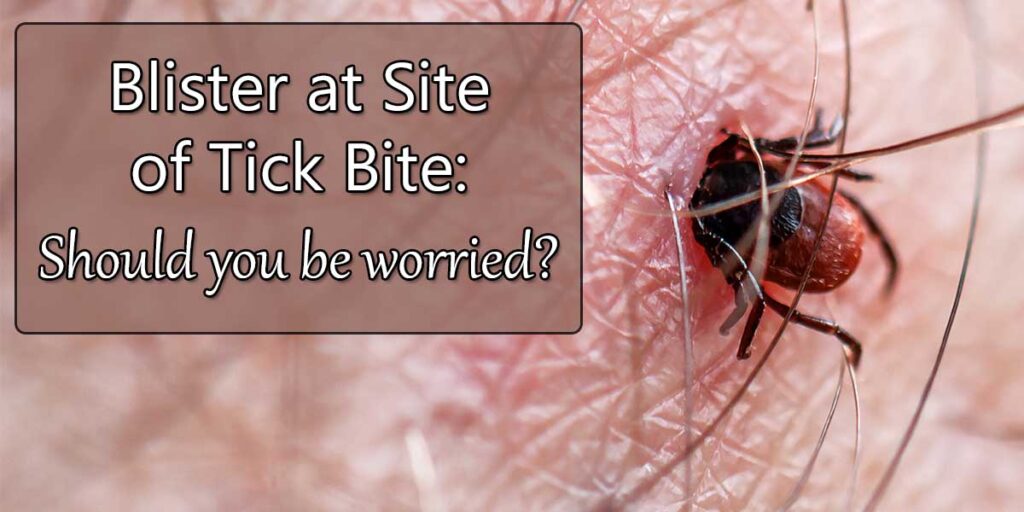











Post your comments